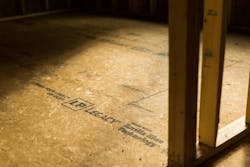What’s in Store for Housing in 2019
The new year brings an opportunity to look ahead—to crunch the numbers, predict the trends, and prepare for what’s to come. What does 2019 have in store? Here’s a look at some of the predictions and expectations, both economic and stylistic.
Housing Expectations
As most witnessed, the housing market weakened a bit in the second half of 2018. The NAHB expects the year to show a decline in existing home sales, says Chief Economist Robert Dietz, but new-home sales and single-family starts will finish up about 3% and 5%, respectively, versus 2017.
Dietz attributes the slowdown to some familiar themes: Most notably, housing affordability, which is at a 10-year low alongside weak income growth. This is coupled with a run-up in home prices over the past five to six years.
For 2019, Dietz says they’re expecting additional declines in existing home sales, but slight growth in single-family construction since both inventory and unemployment rates remain low.
The NAHB also continues to monitor the impact of the skilled labor shortage (which may ease a bit as construction slows), interest rates (which the association believes will increase only twice in 2019), and tariffs. After months of dramatic increases, lumber prices came down in the second half of 2018 with the drop in housing demand, though Dietz says an increase may occur with the spring, accounting for both construction demand and tariffs.
Design Expectations
From a design perspective, expect some familiar themes as well as a few emerging trends. Among them:
• Open floor plans are still preferred and don’t appear to be going away, says Houzz. “Our 2018 Kitchen Trends Report found that half of renovating homeowners open their kitchen to other interior spaces, with a completely open transition or double doors being the most common,” says Mitchell Parker, a Houzz editor and writer. “That said, we are seeing that homeowners utilize glass and steel dividers between interior rooms to give an open feeling while still providing some privacy and noise control.”
Susan Bady, senior editor for Professional Builder and Custom Builder magazines, agrees. “Most homebuyers, regardless of demographic and geography, prefer open plans and strong indoor/outdoor connections. Along with higher ceilings and well-placed glass, they make smaller homes live larger.”
• The desire for outdoor living spaces is not abating, nor is the blurring of lines between inside and out. In AIA’s latest Home Design Trends survey, it was the top specialty area, with 56% of architects reporting popularity increasing (though it fell from 70% the year before). Large sliding and folding doors are increasingly available in a range of price points, opening up the trend to a wider swatch of homebuyers. “One in five homeowners is opening their kitchens to the outdoors to expand living space,” says Parker. “Expect to see more kitchens completely opening up to decks and patios in 2019.”
• Flexibility also continues to be in demand. “The majority of homeowners will always look for ways for rooms to perform double-duty,” Parker says. “We see many photos on Houzz with laundry rooms, for example, that combine the function of mudrooms and extra pantry storage and even have space for a small home office or ‘command’ hub for sorting mail and managing family calendars and chores.”
• According to AIA’s survey, the popularity of infill development is increasing, with 63% of respondents indicating such versus 59% the year before. “Infill and adaptive reuse activity is steadily increasing as raw land becomes more scarce and expensive and urban/suburban housing stock ages and deteriorates,” Bady says.
• “Modern architecture is still popular, especially mid-century modern. Modern or contemporary styles softened by wood or stone are especially desirable for buyers who find true modern too severe,” Bady notes. “Then there's modern farmhouse, which still pervades production-builder portfolios and custom homes.”
• Large kitchen islands continue to be popular, and that means builders need to pay attention to what’s underfoot. A stronger subfloor can help reduce squeaks and bounces that can be exacerbated by islands. LP Legacy® premium sub-flooring can help ensure a higher-quality floor because it offers superior moisture resistance, along with strength and stiffness. Its density provides for better fastener holding and less deflection, which creates a more solid feel and less likelihood for nail pops and movement.
• First-floor master bedrooms remain in demand and were a top feature in the AIA survey. What’s more, “Master-down plans aren't just for empty nesters,” says Bady. “The trend of multigenerational living is driving master-down and sometimes dual master suites, one up, one down, so that older parents/relatives can live on the first floor. A related trend is the finished basement or lower level that can be converted to additional living space, typically for boomerang kids.”
• From black matte faucets to black stainless steel appliances, dark finishes are cropping up around the kitchen and bath, and specialty finishes like brushed brass or copper tones are gracing lights as well as kitchen and bath fixtures. Houzz’s top 10 home design predictions for 2019 foresees black cabinets paired with white walls, backsplashes and countertops.
To learn more about LP Legacy, its premium features, and its “Covered Until It’s Covered” warranty, visit www.lpcorp.com/legacy.


